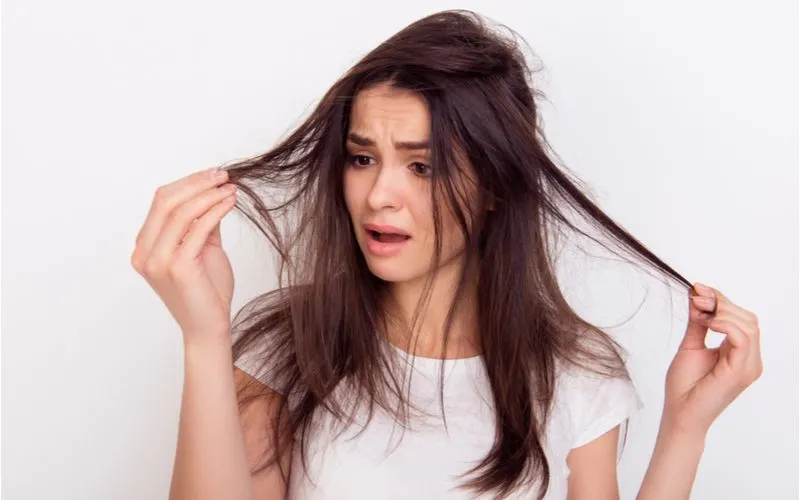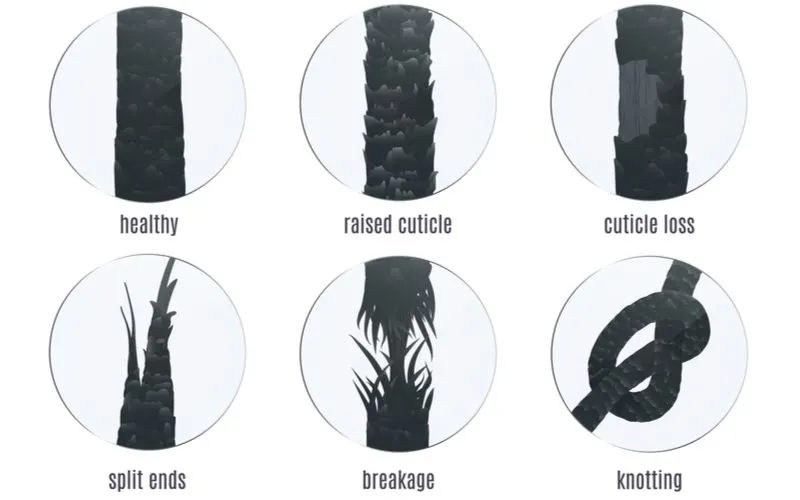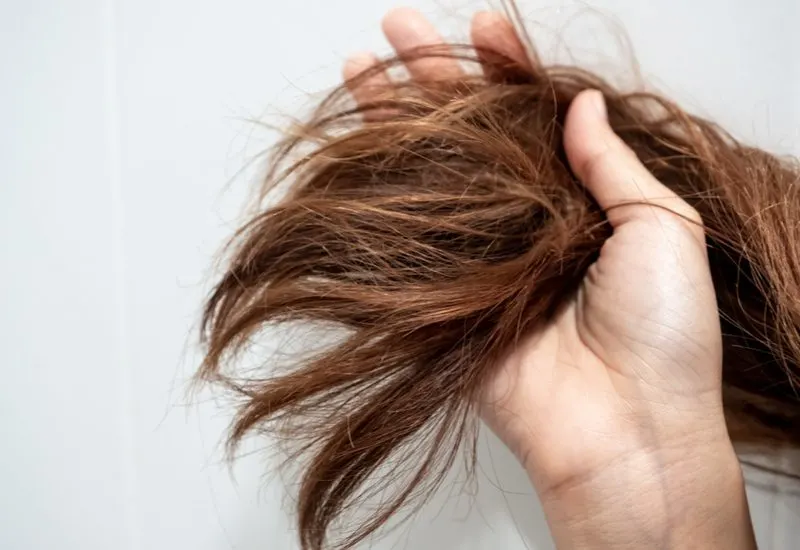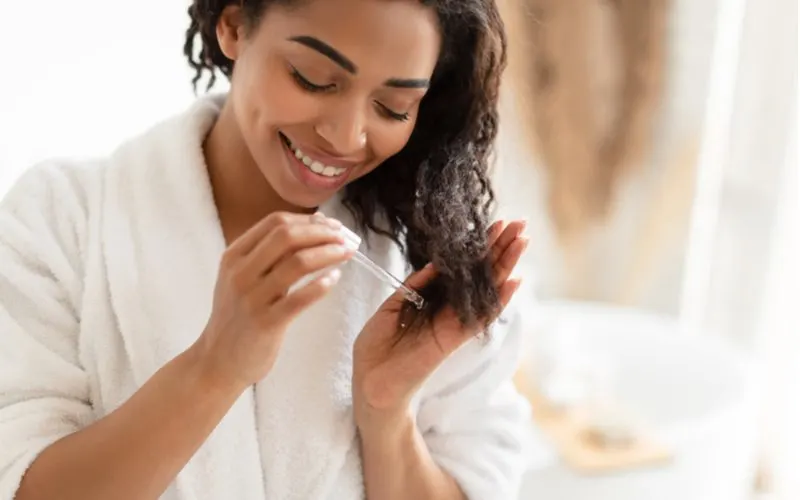Jump to:
It can be easy to miss the signs of damage that lead to dull, lifeless hair. Read on to learn how to tell if your hair is damaged and when it might be in need of some TLC. Your locks will thank you later.
What Is Hair Damage?

Roman Samborskyi/Shutterstock
Hair damage is a common problem for men and women alike. When factors such as heat, chemicals, or weather chip away at the protective outer layer of your locks, it can leave the inner protein core vulnerable to damage. There are plenty of warning signs to watch out for:
- Split ends
- Breakage and shedding
- Dry, dull, or lackluster locks
- Less bounce and elasticity
- Excessive tangling
Plenty of people suffer from dry, frizzy, or unruly locks, but how can you tell when your hair is truly damaged?
Here, we’re going to cover the different causes of hair damage and how to tell if your hair might be suffering. Learn how to spot the signs of damage so that you can restore your hair to a lush, healthy state.
You Might Also Like:
What Causes Hair Damage?

Art4stock/Shutterstock
If you see signs of hair damage, it’s a good idea to figure out the root cause. Otherwise, you may end up damaging new growth and perpetuating the cycle. There are several common causes of hair damage that may be behind any dull, dry, or frizzy locks.
Heat Damage
Many people use heat tools such as blow dryers, hair straighteners, and curling irons to style their hair. While this might make you look sharp in the short-term, excessive heat can cause irreparable damage over time.
When you apply heat, especially without any heat protectant, it can burn the protective exterior of your hair. Forcing your hair into straight or curled orientations can also weaken its structure, leading to breakage, split ends, and frizz.
Chemical Damage
Chemical products are also popular in hairstyling, including bleaches, lighteners, and dyes. These often weaken the outer cuticle of the hair to remove or deposit color, leading to long-term damage.
Permanent hair treatments can also damage otherwise healthy hair. Permanent curls, or “perms,” and straightening procedures use both chemicals and heat, causing damage and dryness from tip to root.
Styling Damage
Sometimes, simply putting up our hair in the morning can end up causing damage. If you pull too hard, it can permanently injure the follicle and prevent healthy hair growth. With enough damaged follicles, you may see frizzing or even thinning hair.
Hair ties may also damage even healthy hair due to friction. As the band tightens or rubs against your hair, it can cause localized breakage. This friction will lead to an unruly appearance when hair is left down.
Environmental Damage
In some cases, hair damage may be somewhat unavoidable. Even if you avoid heat and harsh chemicals, you may find your hair suffering from exposure to the elements. Environmental damage is a common cause for concern when it comes to healthy hair.
Wind and weather can cause friction that leads to breakage and root damage, while pollutants in the air can weaken the protective cuticle. Sunlight can also lead to hair damage, as it dries and bleaches hair.
The Signs of Hair Damage

OSJPhoto/Shutterstock
If you’re not sure whether your hair is showing symptoms of damage, we’re here to help. There are several surefire signs that can let you know whether or not your hair needs some attention.
Split Ends
When hair becomes dry or brittle, the ends can fray to cause split ends. You might see a variety of split-end styles, from forked hairs strands to thinning tips. Split ends are more likely in damaged hair and make it look even more frizzy, particularly the tips. The best way to combat split ends is through regular trims.
Dull, Dry Locks
Damaged hair often appears limp and lifeless. It doesn’t catch the light or have a lustrous shine like healthy hair due to the rough texture of the cuticle. Damaged hair also lacks the moisture it needs to stay soft and supple, making it feel dry or slightly crunchy.
Hair Breakage
When hair dries out, or if the protective outer structure weakens, it can lead to breakage. As damaged, fragile strands snap in half, you may start to notice frizz and flyaways appearing. Breakage is even more likely in hair that’s frequently put up or styled. The best way to prevent breakage is by treating hair gently and keeping it healthy and hydrated.
Less Bounce
Damaged hair often loses its vitality, appearing limp or listless. Some people even lose their curls due to hair damage. While healthy hair has a certain amount of elasticity that lends it a playful bounce, damaged hair often lies flat. Instead of stretching when wet, strands will snap or break.
Thinning Hair
While hair loss is less common in women than men, people across all spectrums experience thinning hair and the anxiety that comes along with it.
Thin hair may be a sign of damage, as unhealthy hairs are thinner, more fragile, and more likely to break off than thick, healthy locks. However, keep in mind that other factors such as pregnancy or certain medications can also lead to thinning hair.
More Tangles
Damaged hair tends to have a dry, cracked outer layer instead of a smooth and silky cuticle. This rough surface snags on other hairs easily, making tangled more likely in the presence of damage. It can also make brushing more difficult, as bristles are more likely to catch and snag on hair strands.
Things to Consider

Prostock-Studio/Shutterstock
If you have damaged hair, there are a couple of things to consider during the repair and recovery process:
- Sometimes, hair care products can cause more harm than good when it comes to damaged locks. Avoid washing or styling your hair with anything containing toxic ingredients such as phthalates, parabens, and sulfates that could cause further damage.
- Washing your hair too much can actually end up drying it out and causing damage, even with safe products. You should avoid shampooing every day and stick to a less frequent schedule instead.
- If your hair gets damaged beyond repair, don’t worry. Our hair can grow at over half an inch per month. With time and care, you’ll have a full head of lush, healthy new hair in no time.
- You can support healthy hair growth by consuming plenty of vitamins, minerals, and healthy proteins. Keratin treatments may also help hair to grow thicker and faster.
- Avoid treating new roots to any harsh conditions that left your old hair feeling dry and damaged. Keep away from chemicals and dyes, heat treatments, or extreme environmental conditions and protect new growth with healthy oils and gentle cleansers.
Frequently Asked Questions
Below are some commonly asked questions regarding damaged hair.
Can you repair damaged hair?
Hair damage due to heat, chemicals, or environmental factors is permanent in most cases. Unlike most of our bodies, hair contains no living tissue and can't heal or regenerate with time. No matter how many products you apply, you won't see any long-term difference in the appearance of damaged hair. That being said, our hair is constantly growing, and new, fresh roots won't show the same damage as the tips. The best way to treat damaged hair is to give it time to grow out and protect the new roots.
What does damaged hair look like?
It’s fairly easy to spot hair damage based on appearance alone. While healthy hair is sleek and smooth, damaged hair will be brittle, frizzy, and unruly. In extreme cases, hair may even appear fried or straw-like in appearance. You can also identify hair damage by touch. Instead of feeling silky, hair will feel rough and stiff. Heavily damaged hair may even feel a little bit crunchy when you handle it. Excessive heat and chemicals often lead to a rough hair texture.
Will damaged hair have healthy growth?
In most cases, no matter how heavily damaged your hair might be, you can count on it growing back out to reveal healthy, luscious locks. The only time you might expect to see permanent hair loss is when the scalp or follicles themselves get damaged.
Can I use coconut oil on damaged hair?
Coconut oil offers a healthy, all-natural way to treat and protect damaged hair. It can help condition and smooth to prevent frizz and flyaways while adding some extra shine to dull locks. Coconut oil even helps to prevent further protein loss in damaged hair. Keep in mind that while coconut oil can help remedy hair damage, it’s not a permanent solution. Even coconut oil can’t repair brittle or broken hair strands. However, it will help to prevent further damage and promote healthy new growth around your roots.
So, How Do You Tell If Your Hair Is Damaged?
If your hair simply doesn’t behave the way you want, it might not be due to your styling skills. Damage caused by heat, chemicals, or environmental factors often causes hair to look dry and listless, no matter how much you pamper it.
If you notice hair damage, the best thing you can do is change your hair care routine to protect new growth for full, luscious locks.
